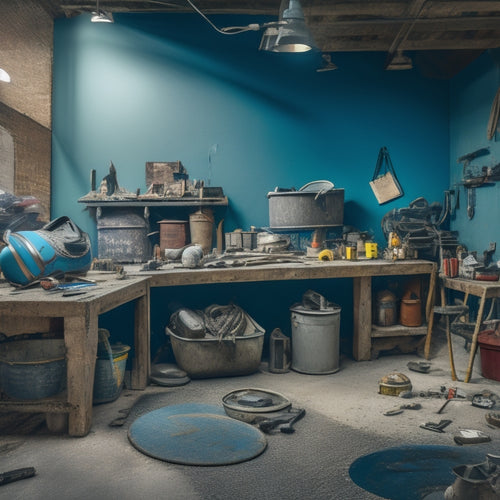
10 Essential Brick Cutting Tools for Concrete
Share
You need a reliable arsenal of cutting tools to tackle any brick or concrete project efficiently, and selecting the right ones can make all the difference in achieving professional-looking results and meeting project deadlines. From diamond blade saws and handheld circular saws to electric tile nippers, wet cutting saws, and concrete pavers cutting machines, each tool serves a specific purpose. You'll also want to evaluate masonry saws, reciprocating saws, tile and brick snappers, and hydraulic splitters for heavy-duty tasks. With the right tools and techniques, you'll be able to tackle any project with confidence - and understanding how to choose and use them effectively is just the starting point.
Key Takeaways
• Selecting the right diamond blade saw depends on the type of cut, material size, and saw power for efficient cutting.
• Handheld circular saws are portable and versatile for precise cuts in tight spaces and corners, ideal for cutting bricks and pavers.
• Wet cutting saws with constant water flow minimize airborne particles, reducing dust and improving visibility during cutting.
• Masonry saws achieve precise, straight cuts in concrete and masonry materials, requiring the right blade selection for clean cuts.
• Angle grinders are versatile tools for shaping bricks around obstructions or curves, offering flexibility for precise cuts and smoothing rough edges.
Diamond Blade Saw Selection
When selecting a diamond blade saw for concrete cutting, you'll find that the ideal choice hinges on the type of cut you need to make, the size of the material, and the power of your saw.
Don't worry, we've got you taken care of! There are several diamond blade types to choose from, each designed for specific tasks. For instance, segmented blades are perfect for rough cuts, while continuous rim blades are better suited for smoother finishes. You'll also want to take into account the blade's diameter, arbor size, and horsepower requirements.
But it's not just about the blade itself – maintenance is key! Regularly cleaning and inspecting your blade will guarantee it lasts longer and performs better. Make sure to check for worn or damaged segments and replace them as needed.
You should also store your blade in a dry place to prevent rust. By choosing the right diamond blade saw and keeping it in top shape, you'll be cutting through concrete like a pro in no time!
Handheld Circular Saws for Brick
You'll find handheld circular saws for brick cutting to be a more portable and versatile alternative to diamond blade saws, allowing you to make precise cuts in tight spaces and corners.
These saws are perfect for cutting bricks, blocks, and pavers, and their compact design makes them easy to maneuver in confined areas.
When using a handheld circular saw, remember to take necessary safety precautions, such as wearing protective gear like safety glasses, dust masks, and gloves.
Also, guarantee the saw is properly maintained by regularly cleaning the blade and checking for wear and tear.
To get the most out of your saw, follow some simple maintenance tips: lubricate the blade regularly, store the saw in a dry place, and avoid exposing it to extreme temperatures.
By following these guidelines, you'll be able to make accurate cuts with ease and confidence.
With the right handheld circular saw and a bit of practice, you'll be a brick-cutting pro in no time!
Electric Tile Nippers for Precision
Cut precise curves and irregular shapes in bricks, blocks, and pavers with electric tile nippers, which offer unparalleled control and accuracy for intricate cuts. These power tools are designed to make precision cutting techniques a breeze, allowing you to tackle complex projects with confidence. One of the electric nipper advantages is their ability to cut curves and irregular shapes with ease, making them ideal for decorative brickwork or intricate paver designs.
Here are some key features to evaluate when selecting electric tile nippers:
| Feature | Description |
|---|---|
| Cutting Capacity | Up to 1.5 inches thick for bricks and pavers |
| Speed | Variable speed control for precise cuts |
| Ergonomics | Comfort grip handle for reduced fatigue |
| Dust Collection | Integrated dust collection system for a cleaner work environment |
| Safety Features | Overload protection and thermal overload protection |
Wet Cutting Saws for Dust Control
For efficient dust control and reduced cleanup, turn to wet cutting saws, which utilize a constant water flow to minimize airborne particles and debris during the cutting process.
You'll be amazed at how much easier it's to breathe and see what you're doing without a cloud of dust surrounding you. Plus, the water helps to cool the blade, reducing wear and tear and making blade maintenance a whole lot easier.
When using a wet cutting saw, make sure you've got a good water containment system in place. You don't want water splashing everywhere, making a mess and creating more work for yourself.
A simple tray or pan under the saw will do the trick. Just remember to empty it regularly to avoid overflow.
Concrete Pavers Cutting Machines
Operating concrete pavers cutting machines requires careful planning and attention to detail to guarantee precise cuts and minimize waste.
You're not just cutting pavers; you're creating a work of art - okay, maybe not art, but at least a professional-looking patio or driveway. To achieve this, you'll need to master paver installation techniques, which include measuring, marking, and cutting pavers to fit snugly together.
When using concrete pavers cutting machines, it's crucial to follow maintenance tips to make sure the machine runs smoothly and efficiently.
Regularly clean the machine, lubricate moving parts, and check the blade's condition to prevent wear and tear. You don't want your machine to break down mid-project, leaving you with a pile of uncut pavers and a deadline looming.
Angle Grinders for Brick Shaping
Angle Grinders for Brick Shaping
You'll find that angle grinders are a more versatile and effective tool than concrete pavers cutting machines when it comes to shaping bricks to fit around obstructions or creating curved patterns. With the right techniques and safety precautions, angle grinders can help you achieve professional-looking results.
When it comes to brick shaping techniques, angle grinders offer unparalleled flexibility. Whether you need to make precise cuts or smooth out rough edges, an angle grinder is the perfect tool for the job.
| Safety Feature | Why It Matters |
|---|---|
| Dust mask | Protects you from inhaling hazardous dust and debris |
| Safety glasses | Shields your eyes from flying particles |
| Grip handle | Reduces fatigue and improves control |
Masonry Saws for Straight Cuts
You can achieve precise, straight cuts in concrete and masonry materials with a masonry saw, making it an indispensable tool for any project requiring accurate, linear cuts. This is especially important when working with masonry techniques that demand precision, such as creating intricate designs or patterns.
To get the most out of your masonry saw, keep the following tips in mind:
-
Choose the right blade: Select a blade designed specifically for masonry materials to guarantee clean, precise cuts.
-
Keep it clean: Regularly clean the saw and blade to prevent dust and debris buildup, which can affect cutting safety.
-
Use proper cutting techniques: Apply gentle, consistent pressure to prevent kickback and maintain control.
-
Wear protective gear: Always wear safety glasses, gloves, and a dust mask to protect yourself from flying debris and dust.
-
Maintain the saw: Regularly check and maintain the saw's motor, bearings, and other moving parts to guarantee ideal performance and extend its lifespan.
Reciprocating Saws for Demolition
When precision is less important than sheer cutting power, reciprocating saws take center stage for demolition tasks, providing the brute force needed to tear through concrete and masonry materials with speed and efficiency.
You'll be amazed at how easily these saws can rip through even the toughest materials, making them a go-to tool for demolition techniques.
However, don't get too carried away – safety precautions are essential when working with reciprocating saws.
Make sure you're wearing proper protective gear, including gloves, safety glasses, and a dust mask.
As you tackle your demolition project, keep in mind that reciprocating saws are designed for aggressive cutting, so be prepared for a bit of chaos.
You'll want to clear the area of any debris or obstacles that could get in the way of your saw or cause injury.
With the right technique and a healthy dose of caution, you'll be able to tear through concrete and masonry like a pro.
Just remember to keep your wits about you and your saw under control – after all, you don't want to end up with a demolition disaster on your hands!
Tile and Brick Snappers for Speed
When you need to make precise tile breaks quickly, you'll appreciate the efficiency of tile and brick snappers.
These tools allow you to snap tiles and bricks with ease, giving you clean breaks and minimizing waste.
Snap With Ease
Tile and brick snappers, designed for speed and efficiency, enable effortless snapping of concrete blocks and tiles into precise sections.
With these tools, you'll be snapping like a pro in no time, mastering brick snapping techniques and efficient cutting strategies.
Say goodbye to tedious and time-consuming cutting methods, and hello to a world of speed and precision.
Here are some key benefits of using tile and brick snappers:
-
Effortless snapping: Snap concrete blocks and tiles with ease, without exerting excessive force or straining your back.
-
Precise control: Achieve accurate cuts with minimal waste, ensuring your projects turn out exactly as planned.
-
Increased productivity: Snap multiple pieces quickly and efficiently, saving you time and energy.
-
Reduced fatigue: Minimize physical strain and reduce the risk of injury with these easy-to-use tools.
-
Professional results: Produce high-quality cuts that meet professional standards, every time.
Precise Tile Breaks
By harnessing the power of tile and brick snappers, you can achieve precise tile breaks at incredible speeds, making it possible to complete projects faster than ever before.
These snappers are designed to help you snap tiles quickly and accurately, allowing you to focus on the finer details of your project. With the right tile alignment techniques, you can guarantee that your tiles are perfectly aligned, and with accurate measurement tools, you can make precise cuts that fit together seamlessly.
When using tile and brick snappers, it's vital to follow the manufacturer's instructions and take necessary safety precautions.
You'll want to make sure you're wearing protective gear, such as gloves and safety glasses, to prevent injury. Additionally, it's important to choose the right snapper for your specific project, considering factors like tile size and material.
Hydraulic Splitters for Heavy Duty
You'll turn to hydraulic splitters for heavy-duty brick cutting tasks that require immense force and precision to split large, thick, or heavily reinforced concrete blocks. These powerful tools harness hydraulic power to deliver unparalleled splitting efficiency, making them the go-to choice for demanding projects.
Here are some key benefits of hydraulic splitters:
-
Unmatched Force: Hydraulic splitters can exert forces of up to 100 tons, making them capable of splitting even the toughest concrete blocks.
-
Precise Control: With hydraulic power, you get precise control over the splitting process, reducing the risk of damage to the surrounding material.
-
Increased Productivity: Hydraulic splitters can split concrete blocks faster than manual or electric tools, saving you time and effort.
-
Reduced Fatigue: With hydraulic power doing the heavy lifting, you can work for longer periods without fatigue.
-
Versatility: Hydraulic splitters can be used for a variety of heavy-duty applications, from demolition to quarrying.
Frequently Asked Questions
What Safety Gear Is Necessary When Operating Brick Cutting Tools?
When you're about to get loud and messy with those brick cutting tools, don't forget to suit up!
You'll need safety goggles to protect those peepers from flying debris and dust.
And, trust us, you won't want to be that person who's stuck with permanent ringing in their ears - grab some hearing protection too.
It's not just about looking cool, it's about preserving your senses (and your sanity) on the job site.
Can Brick Cutting Tools Be Used on Other Masonry Materials?
You're wondering if brick cutting tools are one-trick ponies or if they can handle other masonry materials.
Well, you'll be happy to know that most brick cutting tools boast impressive versatility! They can tackle a range of materials, from concrete blocks to pavers, and even natural stone.
Compatibility varies, but many tools can be adapted for different masonry materials. You just need to check the specs and adjust your technique.
With the right tool and know-how, you'll be a masonry master in no time!
How Do I Maintain and Store Brick Cutting Tools?
Let's face it, you're probably a hot mess when it comes to tool maintenance. But don't worry, we've got your back!
To keep your brick cutting tools in top shape, you'll need to prioritize tool cleaning and storage solutions.
Start by wiping down blades with a wire brush and mild detergent, then dry thoroughly to prevent rust.
Next, invest in a sturdy storage case or toolbox to keep your tools organized and protected.
Trust us, your tools (and your sanity) will thank you.
Are There Any Specific Regulations for Brick Cutting in Residential Areas?
When you're planning to cut bricks in residential areas, you're not just worrying about making a mess - you've got to navigate local zoning laws and noise ordinances too!
You'll need to check with your local government to see if there are any specific regulations governing noise levels, especially if you're planning to cut bricks during quiet hours.
Don't get caught off guard - do your research to avoid any fines or unhappy neighbors!
Can I Rent Brick Cutting Tools Instead of Purchasing Them?
You're wondering if renting brick cutting tools is a cost-effective alternative to buying them outright.
Well, let's crunch some numbers! A cost comparison reveals that renting can be a smart move, especially for small-scale projects or one-time gigs.
Check out rental options at local hardware stores or online marketplaces. You might be surprised at the affordability and convenience of renting high-quality tools, freeing up your budget for more important things... like coffee and biscuits!
Conclusion
You've now got the essential brick cutting tools for concrete in your arsenal.
The theory that having the right tool for the job guarantees precision, efficiency, and safety holds true.
With these 10 tools, you'll be able to tackle any concrete cutting task with confidence.
Whether it's precision cuts, demolition, or dust control, you'll be equipped to handle it.
The result? Flawless cuts, reduced waste, and a professional finish that meets industry standards.
Related Posts
-

What Tools Do You Need for Concrete Success
For concrete success, you'll need a range of essential power tools, including rotary hammers, angle grinders, concret...
-

What Tools Do You Need for Concrete Flooring
You'll need a thorough arsenal of specialized tools to achieve a high-quality, professional-looking concrete floor, i...
-

5 Tips for Accurate Concrete Measurement Tools
To guarantee accurate concrete measurement, you'll want to calibrate your measuring tools regularly, choosing a frequ...


